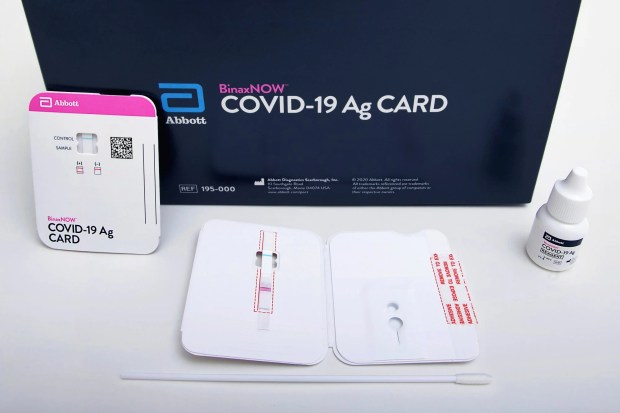It’s Thanksgiving, and rapid COVID tests are about to get their moment.
With families and friends gathering in numbers not seen since the start of the pandemic, there’s a good chance many of us are getting the sniffles before heading to grandma’s house for a turkey feast around a crowded table — indoors.
Is it just allergies from the ill-advised scented pinecone you bought the other day? Or a potentially deadly disease? Enter the rapid at-home COVID test with results in 15 minutes. How do they work? Where do you get them? And is any Thanksgiving gathering complete without them? We explore and explain.
How at-home tests work
Rapid tests are called antigen tests, and they’re a little different from the PCR tests that your health care provider probably offers. Antigen tests identify proteins of the virus — SARS-CoV-2 — that causes COVID-19. They tell you whether you are infectious at the time of testing, which is useful information heading into a holiday season where you might be interacting with vulnerable loved ones.
One of the most common tests on the market is Abbott’s BinaxNOW, which comes with step-by-step instructions for swabbing your nose, inserting the swab into a few drops of liquid that comes with the kit and reading the results — which, like a pregnancy test, show a control line. If another line appears, that indicates the test is positive. If no other line shows up, that means it’s negative. Other brands include Quidel’s QuickVue test and BD Veritor’s digital test kit.
To state the obvious: Even if you don’t have COVID, but you think you have the flu or some sort of other ailment, consider staying home so you don’t subject others to whatever you’re experiencing.

Where to get a test
If you were in the United Kingdom, the government would be providing free rapid tests, with the option to have them sent to your home. And they encourage testing. In the Bay Area and across the U.S., the process is a little more complicated — and costly. Chain pharmacies like Walgreens and CVS carry at-home tests, along with stores like Walmart and Target. A quick check of Bay Area stores this week showed prices ranging from about $15 to $30 for a two-pack.
Even if you’re willing and able to pay, finding a store with the tests in stock — and often locked away behind a glass case — can be a bit challenging. A store clerk who answered the phone Wednesday at Walgreens in downtown San Mateo said he had one kit left, but could get more by Thursday. An online search Wednesday morning showed that Walmart had tests available in San Leandro but not in Union City, Mountain View or Fremont. Amazon also sells the tests, but delivery can, of course, take a couple of days or more.
Demand for tests appears to be up heading into Turkey Day.
“We continue to see increased demand for OTC COVID-19 tests across the country and are working with our suppliers to ensure customers have access to self-test kits through the holidays,” Walgreens said in a statement.
Cue the mad dash for tests at the drug store.
“It’s like toilet tissue at the start of the pandemic,” said Monica Gandhi, a UCSF infectious disease expert.
That is, unless you work for one of the tech giants in the region that has stockpiled tests and made them available to employees.
The good news is that supply could soon increase. The U.S. Food and Drug Administration this week approved three new over-the-counter antigen tests for use and the Biden administration has vowed to expand rapid testing in the coming months.
When to test
Should you take a rapid test? That depends.
“My advice would be if you’re fully vaccinated and going to be with a group of people you know are fully vaccinated, and you trust those people that they’re not going to come if they have the slightest symptom that could be early COVID, I don’t think there’s a need for antigen testing,” said John Swartzberg, professor emeritus of infectious disease and vaccinology with the UC Berkeley-UCSF Joint Medical Program.
But, Swartzberg said, if you’re visiting someone elderly or immunocompromised — or you might have been exposed a few days earlier — testing can “add that additional layer” of peace of mind.
He and his wife are planning to do a home test before their granddaughters come over for Thanksgiving because the youngest is just partially vaccinated.
“It’s probably overkill, but it’ll make our granddaughter more comfortable,” he said.
One group you can probably skip testing? The preschool set.
Young children “are very low transmitters,” Gandhi said.
She also offered a word of caution: follow the directions carefully.
“If you keep it out too long, it can look like a positive,” she said. “False positives are a problem.”
But, she said, “If it’s negative, it is usually negative. You can feel good about that.”
The broader picture
While COVID cases are trending up in other parts of the U.S., that’s not what we’re seeing in California. Statewide, we’re seeing about 10 new cases per 100,000 people, with testing positivity at just 1.9%. Fully vaccinated people — which is most of us in the Bay Area — are 7.2 times less likely to get COVID-19 than our unvaccinated peers.
“We are really lucky to be here right now,” Swartzberg said, “because what’s going on in a lot of the rest of the country, it’s not a pretty picture.”
Source: www.mercurynews.com
